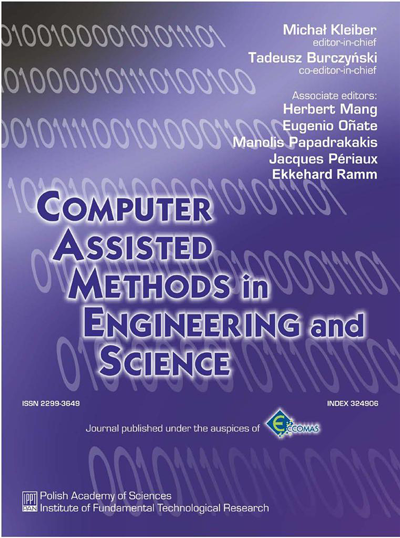SVD as a preconditioner in nonlinear optimization
Abstract
Finding a solution of nonlinear constrained optimization problem may be very computer resources consuming, regardless of solution method adopted. A conceptually simple preconditioning procedure, based on singular value decomposition (SVD), is proposed in the current paper in order to speed up the convergence of a gradient based algorithm to solve constrained minimization problem having quadratic objective function. The efficiency of the proposed procedure is tested on a constrained minimization problem with quadratic objective function and quadratic constraints. Accuracy of the results obtained using proposed preconditioning method is checked and verified against the results determined without the preconditioning procedure.
Results obtained so far seem to indicate a significant speedup of the calculations at the expense of, negligible from the engineering point of view, loss of accuracy.
Keywords
numerical method, nonlinear optimization, singular value decomposition,References
[1] S.P. Bod, L. Vandenberghie. Convex optimization. Cambridge University Press, 2004.[2] W. Cecot, J. Orkisz. Prediction of actual residual stresses resulting from cyclic loading in kinematic hardening material. Proc. of COMPLAS V, 1879–1891, Barcelona, 1997.
[3] T.F. Chan. An improved algorithm for computing the singular value decomposition. ACM Transactions on Mathematical Software, 8: 72–83, 1982.
[4] K. DangVan, B. Griveau, O. Message. On new multiaxial fatigue criterion: theory and application. Biaxial and multiaxial fatigue, 479–496, MEP, London, 1989.
[5] J. Demmel, W. Kahan. Accurate singular values of bidiagonal matrices. Society for Industrial and Applied Mathematics. Journal on Scientific and Statistical Computing, 11: 873–912, 1990.
[6] R. Fletcher. Practical methods of optimization. Wiley, 2000.
[7] J.B. Martin. Plasticity – fundamentals and general results. MIT Press, 1975.
[8] J.C. Nash. A one-sided transformation method for the singular value decomposition and algebraic eigenproblem. Computer Journal, 18: 74–76, 1975.
[9] J.C. Nash, S. Shlien. Simple algorithms for the partial singular value decomposition. Computer Journal, 30: 268–275, 1987.
[10] G.L. Nemhauser, A.H.G. Rinooy Kan, M.J. Todd. Optimization. North Holland, 1989.
[11] J. Nocedal, S.J. Wright. Numerical optimization. Springer, 2006.
[12] J. Orkisz, A. Harris. Analysis of residual stresses at shakedown, a hybrid approach. Theoretical and Applied Fracture Mechanics, 9: 109–121, 1988.
[13] J. Orkisz, O. Orringer, M. Hołowiński, M. Pazdanowski, W. Cecot. Discrete analysis of actual residual stresses resulting from cyclic loadings. Computer and Structures, 35: 397–412, 1990.
[14] J. Orkisz, M. Pazdanowski. On a new feasible directions solution approach in constrained optimization. In: E. Onate, J. Periaux, A. Samuelsson, eds. The Finite Element Method in the 1990’s, 621–632. Springer Verlag, 1991.
[15] J. Orkisz, M. Pazdanowski. On increasing the convergence of the new feasible directions method in nonlinear optimization. Proc. of the X PCCM, 591–597, Świnoujście, 1991.
[16] J. Orkisz, M. Pazdanowski. Analysis of residual stresses by the generalized finite difference method. Proc. of COMPLAS IV, 189–200, Barcelona, 1995.
[17] M. Pazdanowski. On estimation of residual stresses in rails using shake-down based method. Archives of Transport, XXII(3): 319–336, 2010.
[18] W.H. Press, S.A. Teukolsky,W.T. Vetterling, B.P. Flannery. Numerical recipes in Fortran. Cambridge University Press, Cambridge, 1992.
[19] J.C. Spall. Introduction to stochastic search and optimization: estimation, simulation and control. Wiley, 2003.
[20] G.W. Stewart. On the early history of the singular value decomposition. SIAM Review, 35: 551–566, 1993.
[21] LAPACK users’ guide. SIAM, 1999.
[22] GNU scientific library reference manual – third edition. Network Theory, 2009.




